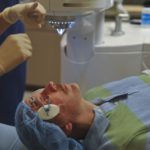
Cataract Treatment
Regular check-ups ensure quick diagnosis of all types of cataracts
Developing cataract after the age of 60 is a fairly common phenomenon. However factors such as diabetes and high blood pressure can play a role in development of cataract at a younger age. Sometimes cataracts can also present themselves at birth. There can be more than one variety of cataracts.Though most cataracts develop gradually and can have planned surgeries, there are certain types which may need quick intervention.
POONA EYE CARE HAS A HIGHLY EXPERIENCED TEAM FOR CATARACT SURGERIES
We have a very good medical and para medical team to ensure correct diagnosis and appropriate treatment for cataract. Our team has performed over 40,000 cataract surgeries in the last 10 years. We have adapted the latest methodologies of cataract treatment which ensure maximum comfort and fast recovery after the surgery.
Drag ![]() left/right for full view
left/right for full view


| Vision Before Treatment | Vision After Treatment |
Frequently Asked Questions
What is a cataract?
A cataract is ‘decrease in vision created by clouding or opacity in the natural eye-lens’. The cause of this clouding/opacity is not clearly understood, but most cataracts are caused by changes in the protein structures within the lens. In a normal eye, light passes through the transparent lens to the retina. Once it reaches the retina, light is changed into nerve signals that are sent to the brain.The lens must be clear for the retina to receive a sharp image. If the lens is cloudy from a cataract, the image you see will be blurred.
How common is it ?
Cataract is a very common eye condition. Untreated cataracts are the single largest cause of blindness in the world. But the condition is usually reversible with a cataract operation.
Who is likely to be affected by cataract?
- Aging is the most common cause of cataract. Hence elderly people are most prone to developing advanced cataract that needs surgery.
- Hereditary causes such as enzyme defects or genetic issues can present cataract at birth or childhood, but this is very rare.
- Severe trauma to the eye or intraocular inflammation can hasten the development of cataract.
- Excessive ultraviolet light exposure, exposure to ionizing radiation are some factors believed to cause cataract.
- Diabetes, smoking, or the use of certain medications such as oral, topical or inhaled steroids, long-term use of statins and phenothiazines can also result in development of cataract.
- Other precipitating factors can be heavy alcohol use, obesity and high blood pressure.
What are the symptoms indicating cataract?
- Blurry vision.
- Trouble seeing at night.
- Seeing colors as faded.
- Increased sensitivity to glare.
- Halos surrounding lights.
- Double vision in the affected eye.
- A need for frequent changes in prescription of glasses.
Why does a cataract need treatment?
A cataract results in blurred vision. You might end up with cataracts in both eyes, but they usually don’t form at the same time. It develops slowly and eventually interferes with your vision, thus daily activities. Although some stop growing, they don’t get smaller on their own. A cataract may lead to blindness when left untreated.
We generally recommend surgery when cataracts take a toll on daily activities and affect reading,driving and even nominal chores. We are left with no option but a surgery, when cataracts interfere with the treatment of other eye problems.
What are the different types of cataract?
There are three primary types of age-related cataracts: nuclear sclerotic, cortical and posterior subcapsular. As a person ages, any one type, or a combination of any of these three types, can develop over time.
Nuclear Sclerotic Cataracts
This is a very common, usually slow progressing age related cataract. The nuclues, which is the central portion of the natural eye lens hardens (sclerosis) over-time, hence the name. In this type of cataract, your ability to focus/read actually improves for sometime before deteriorating.
Cortical Cataract
In cortical cataract white opacities or cloudy areas develop in the peripheral (outside) edge of the lens, which is the lens cortex. Fissures that look like the spokes of a wheel develop in the lens and cause light to get scattered. In addition to the common symptoms of all types of cataract, cortical cataract affects depth and contrast perception. Diabetics are at a higher risk of developing cortical cataracts.
Posterior Subcapsular Cataracts
This cataract starts with a small opaque or cloudy area beneath the lens capsule, which is a sac-like membrane that encloses the lens. Subcapsular cataracts can interfere with reading and create “halo” effects and glare around lights. People who use steroids, or those with diabetes, extreme nearsightedness, and/or retinitis pigmentosa may develop this type of cataract. Subcapsular cataracts can develop rapidly and symptoms can become noticeable within months.
What are the tests used to detect cataract?
Cataract is detected through a comprehensive eye exam that includes:
- Visual acuity test: This eye chart test measures how well you see at various distances.
- Dilated eye exam: Drops are put in your eyes to dilate the pupils. A special magnifying lens is used to examine your retina and optic nerve for signs of damage and other eye problems. After the examination, your close-up vision may remain blurred for several hours.
- IOL Master:IOL Master uses a scanning device to determine the required power for the intraocular lens to be implanted. It is a laser system which evaluates the length of the eye, surface curvature and anterior chamber depth for accuracy.
Other tests may also be required in certain cases. We may check the sensitivity to glare and your perception of colors if needed.
What are the different types of cataract surgeries?
1: Phacoemulsifictaion (Phaco)
The most common type of cataract procedure performed today is called phacoemulsification (or “phaco”) cataract surgery with foldable intraocular lens(IOL) implantation. In this short procedure, the natural eye lens is broken down with ultrasonic energy and removed with gentle suction. It is then replaced with a flexible IOL. This procedure requires a very small incisions and no stitches are needed. Patient does not require over-night hospitalisation. Recovery is fast.
2.MSICS: Manual Small Incision Cataract Surgery
This is a cost-effective method which uses an incision size of 5 to 6 mm. It leaves a self-sealing sutureless wound.
What are the different types of intraocular lenses (IOLs)?
There are many different types of cataract lenses available, and each type of lens provides specific benefits.
Monofocal IOLs
The most common types of cataract lenses are monofocal IOLs. These lenses are usually the standard option. Monofocal lenses only have one focusing distance; either to focus at a distance or to focus very near. Most cataract patients choose monofocal IOLs that allow them to focus at a distance and use reading glasses when needed.
Multifocal IOLs
Multifocal lenses allow you to see well at more than one distance. They also reduce the need for contact lenses and glasses after a cataract surgery. Multifocal lenses are usually only used if they can be implanted into both eyes, and will work best for patients who don’t have any eye diseases. However, those with this type of cataract lenses may notice glare or halos at night, especially right after the surgery.
Accommodating IOLs
This type of lens needs an implant inside the eye as it moves to help you focus at various distances. It provide enhanced distance vision for many cataract patients. However it is not ideal for near vision.
Toric IOLs
Toric IOLs are designed for those with cataracts who want to reduce astigmatism (vision difficulty due to irregular cornea). This type of cataract lens has markings to indicate how the lens should be aligned in the eye. When implanted, the surgeon will adjust the orientation and position of the lens to ensure it provides optimum results. These cataract lenses are available in several powers.
EDOF: Extended Depth of Focus IOL
These IOLs work by creating a single elongated point to enhance the range of vision or depth focus. They are used in correction of presbyopia.
What to expect during a cataract surgery?
Before the surgery
A week or two before surgery, we will do some tests for measuring the curve of your cornea and size and shape of your eyes. This is done to help us choose the right intraocular lens (IOL).
Our doctor will understand the medications you are on, and may stop certain medications temporarily.
During the surgery
First drops will be put into your eyes to dilate the pupil. The area around your eye will be washed and cleansed.
The operation usually takes 10 to 15 minutes in experienced hands and is almost painless. No sedation is usually required. Local anaesthesia is used to numb the nerves in and around your eye.
After the operation,you will be asked to wear an eye shield or eyeglasses to help protect your eye . The medical team will watch for any problems, such as bleeding. If all is well, you will be sent home after a short rest.
After surgery
Itching and mild discomfort are normal after a cataract surgery. Some fluid discharge is also common. Your eye may be sensitive to light and touch. After one or two days, moderate discomfort will disappear. If it persists, talk to your doctor.
For a few weeks after surgery, your doctor will give you eye drops to help healing and decrease the risk of infection. It is essential to use these drops as per the doctor’s instructions.
Avoid rubbing or pressing on your eye.
Try not to bend from the waist to pick up objects on the floor. Do not lift any heavy objects. You can walk, climb stairs, and do light household chores.
In most cases, healing will be complete within two weeks. We will schedule follow-up examination to check on your progress.
Can any problems develop after surgery?
Problems after surgery are rare, but they can occur. These problems can include infection, bleeding, inflammation (pain, redness, swelling), loss of vision, double vision, and high or low eye pressure. With prompt medical attention, these problems can usually be treated successfully.
Back to normal
You can return quickly to many everyday activities. The healing eye needs time to adjust so that it can focus properly with the other eye, especially if the other eye has a cataract.
You will experience that colours are very bright after the surgery. The IOL is clear, unlike your natural lens that may have had a yellowish/brownish tint. Within a few months after receiving an IOL, you will become used to improved color vision. Also, when your eye heals, you may need new glasses or contact lenses.
Are there any risks involved in cataract surgery?
Cataract is usually a safe surgery. However, as with any surgery, cataract surgery poses risks of infection and bleeding. Before the surgery, your doctor may ask you to temporarily stop taking certain medications that increase the risk of bleeding during surgery. After surgery, you must keep your eye clean, wash your hands before touching your eye, and use the prescribed medications to help minimize the risk of infection. Serious infection, though rare, can result in loss of vision.
Cataract surgery may slightly increase the risk of retinal detachment in certain cases with underlying problems. Other eye disorders, such as high myopia (nearsightedness), can further increase your risk of retinal detachment after cataract surgery. One sign of a retinal detachment is a sudden increase in flashes or floaters in front of the eyes. A retinal detachment is a medical emergency. Early treatment for retinal detachment may prevent permanent loss of vision.
What are the precautions we can take to reduce the possibility of developing cataract?
- Protect eyes from UVB rays by wearing sunglasses outside.
- Stop smoking.
- Eat fruits and vegetables that contain antioxidants.
- Maintain a healthy weight.
- Keep diabetes and other medical conditions in check.
Other treatments at Poona Eye Care
Please do write to us if you have any more queries on this. We will be glad to assist.
CONTACT US

- Shop No. 1, Lajawanti Apartments, 62/9 Erandawane, Opposite Sonal Hall, Karve Road, Pune-411004, Maharashtra, India.
- +91 735-027-7779
- info@poonaeyecare.com
Working Hours
- MON: 9:00 AM - 08:00 PM
- TUES: 9:00 AM - 08:00 PM
- WED: 9:00 AM - 08:00 PM
- THUR: 9:00 AM - 08:00 PM
- FRI: 9:00 AM - 08:00 PM
- SAT: 9:00 AM - 01:00 PM



